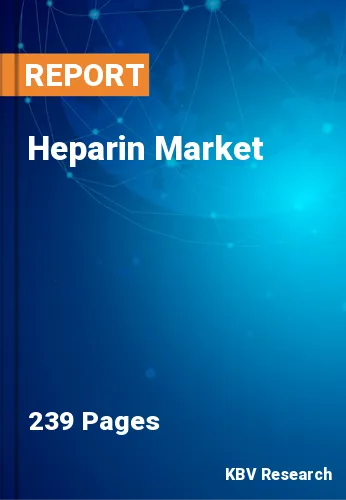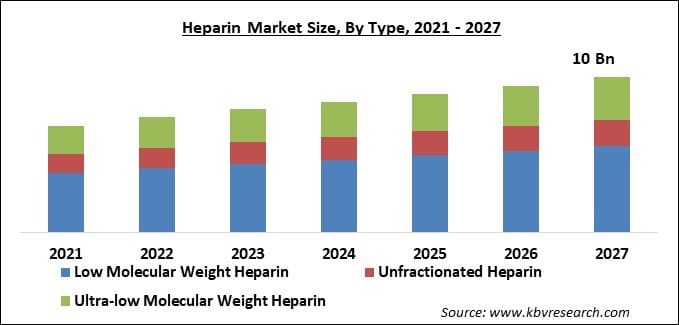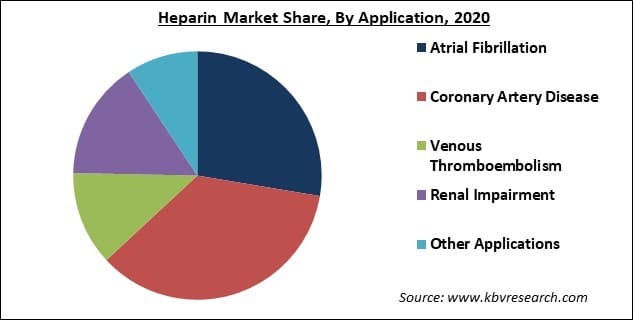
The Global Heparin Market size is expected to reach $10 billion by 2027, rising at a market growth of 6.5% CAGR during the forecast period. Heparin is also called unfractionated heparin (UFH). It refers to a glycosaminoglycan that naturally forms in the body. Heparin is widely used as an anticoagulant in medicine that acts as a blood thinner. Thus, it finds its application in the treatment of unstable angina and heart attacks. It can either injected into a vein or under the skin.
Acute coronary syndrome, pulmonary embolism, atrial fibrillation, deep vein thrombosis, cardiopulmonary bypass & hemofiltration during cardiac surgery can be treated by the use of heparin. Nowadays, it is also used in major orthopedic surgeries like hip and knee replacements.
As per the data published by the Centers for Disease Control and Prevention (CDC) in 2018, it is estimated that more than 900,000 people in the U.S. are suffering from pulmonary embolism and deep vein thrombosis every year. This factor is anticipated to boost the regional demand in the forecast period. The geriatric population is at greater risk of various chronic diseases like deep vein thrombosis and pulmonary embolism. The increasing incidences of chronic diseases will positively influence the expansion of the heparin market across the globe. Moreover, the introduction of highly precise and upgraded heparin products by the market players will boost the growth of the heparin market.

The sudden outbreak of COVID-19 has adversely affected the healthcare sector. It has disrupted workflows in the health care system all across the globe. Due to this viral disease, a number of industries were forced to shut their doors temporarily. It also includes several subdomains of health care. However, it has a positive effect on the heparin market as there is a surge in demand for various medical services. A large number of patients who are suffering from COVID-19, their lungs are severely affected as it is a respiratory disease. The demand for heparin has been increased during the pandemic as it is used to control respiratory inflation. It causes thinning of the blood and reduces the risk of a blood clot.
Anticoagulant medications also include low molecular weight heparins which are well-tolerated and they have fewer side effects. Irrespective of risk ratings, patients who get admitted to the hospital with COVID-19 infection are treated with prophylactic-dose of low molecular weight heparin. In the suspected COVID-19 infected patients, a baseline chest CT scan is performed and they are needed to be admitted to the hospital.
Various scientific studies revealed that the LMW heparin is capable of binding with SARS-CoV-2 Spike protein. So, it can be used as an effective therapeutic approach to reduce thrombosis and pulmonary embolism complications that arise in SARS-CoV-2 patients. As a result, heparin can be used in the treatment of COVID-19 patients. Though, various clinical studies & development are in progress to improve LMWH's efficacy.
Based on Type, the market is segmented into Low Molecular Weight Heparin, Unfractionated Heparin and Ultra-low Molecular Weight Heparin. There is no necessity for daily blood monitoring if treated with LMWH. All these factors are expected to boost the growth of the heparin market. Furthermore, according to a scientific study that was published in NEJM Journal Watch, the low occurrence of heparin-induced thrombocytopenia is expected to contribute towards the segment growth. Ultra-low molecular weight heparin is anticipated to be the fastest-growing segment in the coming years because of the commercialization of these products with enhanced pharmacological effects.

Based on Application, the market is segmented into Atrial Fibrillation, Coronary Artery Disease, Venous Thromboembolism, Renal Impairment and Other Applications. Venous thromboembolism (VTE) would witness fastest growth rate in the heparin market over the forecast years. Venous thromboembolism is of two types viz. pulmonary embolism (PE) and deep vein thrombosis (DVT). Due to increasing awareness about thrombosis, there is increased demand for heparin. It is one of the major factors boosting the segment growth.
Based on Route of Administration, the market is segmented into Subcutaneous and Intravenous. The subcutaneous segment dominated the market in 2020. It would showcase the fastest growth rate and expected to see a lucrative CAGR over the forecast period due to less cost associated with hospitalization. Moreover, according to the patient’s perspective, the subcutaneous route is highly popular among the patients due to its ease of administration and increasing preference for home care, thus reducing the duration of treatment. Furthermore, other benefits of this route of administration comprise a lesser risk of systemic infection and better quality of life.
Based on End Use, the market is segmented into Outpatient and Inpatient. The outpatient segment garnered the maximum revenue share of the market in 2020 and expected to maintain its position over the forecast period. The preference for the subcutaneous route of administration has been increased among the patients. Thus, it is acting as a major factor contributing to the growth of the market.
| Report Attribute | Details |
|---|---|
| Market size value in 2020 | USD 6.4 Billion |
| Market size forecast in 2027 | USD 10 Billion |
| Base Year | 2020 |
| Historical Period | 2017 to 2019 |
| Forecast Period | 2021 to 2027 |
| Revenue Growth Rate | CAGR of 6.5% from 2021 to 2027 |
| Number of Pages | 239 |
| Number of Tables | 440 |
| Report coverage | Market Trends, Revenue Estimation and Forecast, Segmentation Analysis, Regional and Country Breakdown, Companies Strategic Developments, Company Profiling |
| Segments covered | Type, Application, Route of Administration, End Use, Region |
| Country scope | US, Canada, Mexico, Germany, UK, France, Russia, Spain, Italy, China, Japan, India, South Korea, Singapore, Malaysia, Brazil, Argentina, UAE, Saudi Arabia, South Africa, Nigeria |
| Growth Drivers |
|
| Restraints |
|
Based on Regions, the market is segmented into North America, Europe, Asia Pacific, and Latin America, Middle East & Africa. North America dominated the heparin market in 2020. This is due to the rising cases of cardiovascular disorders in this region. Additionally, there is a higher level of healthcare expenditure, and increasing awareness among people which would boost the regional market. Another factor that is likely to drive the demand for heparin is the advanced healthcare infrastructure in this region.
Free Valuable Insights: Global Heparin Market size to reach USD 10 Billion by 2027
The market research report covers the analysis of key stake holders of the market. Key companies profiled in the report include Baxter International, Inc., B. Braun Melsungen AG, Fresenius SE & Co. KGaA, Pfizer, Inc., Sanofi S.A., Teva Pharmaceuticals Industries Ltd., Hebei Changshan Biochemical Pharmaceutical Co., Ltd., Dr. Reddy’s Laboratories Ltd., LEO Pharma A/S, and Viatris, Inc.
By Type
By Application
By Route of Administration
By End Use
By Geography
The global heparin market size is expected to reach $10 billion by 2027.
Increasing initiatives by the government to support R&D activities in drug development are driving the market in coming years, however, Adverse side effects of the heparin in some cases have limited the growth of the market.
Baxter International, Inc., B. Braun Melsungen AG, Fresenius SE & Co. KGaA, Pfizer, Inc., Sanofi S.A., Teva Pharmaceuticals Industries Ltd., Hebei Changshan Biochemical Pharmaceutical Co., Ltd., Dr. Reddy’s Laboratories Ltd., LEO Pharma A/S, and Viatris, Inc.
The demand for heparin has been increased during the pandemic as it is used to control respiratory inflation. It causes thinning of the blood and reduces the risk of a blood clot.
The North America market dominated the Global Heparin Market by Region in 2020.
The asia-Pacific would be the fastest-growing region during the forecast period.
Our team of dedicated experts can provide you with attractive expansion opportunities for your business.
